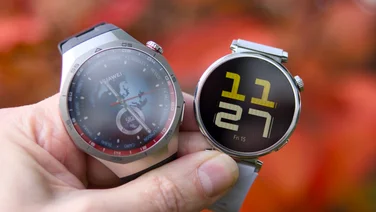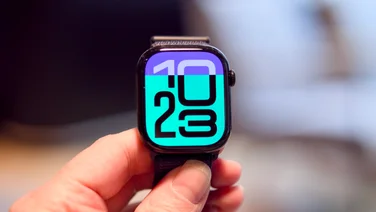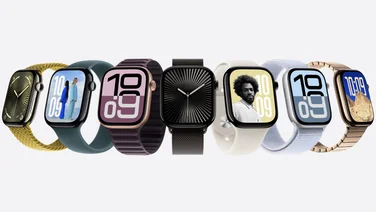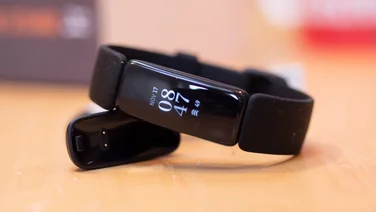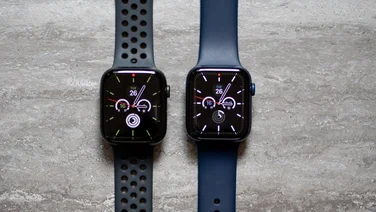To help us provide you with free impartial advice, we may earn a commission if you buy through links on our site. Learn more













- Unparalleled tracking and training feedback
- Full-colour maps with on-the-go routing
- Music storage and Spotify support
- Expensive
- Plastic casing not as smart as metal
Save for the £1400 Marq Athlete, the Garmin Forerunner 945 is the company’s most full-featured wearable, offering in-depth training analysis that even the outstanding Fenix 5 Plus cant match.
Indeed, despite its slim, lightweight design, the Forerunner 945 packs in just about everything you could want from a sports watch including colour maps, music playback and contactless payments, along with an array of sensors that enable it to offer best-in-class sports tracking. When you consider its launched at nearly £100 less than the Fenix 5 Plus, its difficult not to get excited about this superb new sports watch.
Garmin Forerunner 945 review: What you need to know
The Forerunner 945 is, of course, the successor to the Forerunner 935, which came out in 2017. However, because many of the best and most interesting features have trickled down from Garmins flagship ranges, its much more than just an incremental update.













Along with the aforementioned features, the Forerunner 945 supports GPS, GLONASS and Galileo to ensure accuracy in its outdoor tracking, and its waterproof to 5ATM (50m). The watch also has a Pulse Ox sensor, which measures the oxygen saturation of your blood. Other sensors on the watch include Garmins Elevate optical heart rate monitor, a barometric altimeter and a thermometer, and you can also link it up to other sensors including external heart rate monitors, running footpods and cycling power meters via both ANT+ and Bluetooth.
Thanks to its sophisticated training tools, the Forerunner 945 is a watch that can satisfy even the most stat-obsessed athletes, providing enough insights and feedback to help you change your training regime for the better. Don’t forget it has smart features including music storage, too, and onboard maps for turn-by-turn navigation. In short, the Forerunner 945 does it all.













Garmin Forerunner 945 review: Price and competition
At £520, the Forerunner 945 is far from cheap, but its competitively priced with its main competition, which comes from other watches in the Garmin line-up rather than rival brands. To get your hands on such a combination of top-class sports tracking, music playback and maps, youll have to pick between it, the Fenix 5 Plus series (from £459), and the Marq Athlete (£1400). The Forerunner 945 has more in-depth training analysis and a longer battery life than the Fenix 5 Plus series, but otherwise, the watches are only separated by design.
Of course other companies do make very good sports watches, and if you dont need all the smarts of the Forerunner 945 then you can make a big saving by shopping elsewhere. The Coros Apex watch offers good sports tracking, massive battery life and breadcrumb navigation for under £300, for instance, while the Suunto 9 is another solid option thats often available for around £350.
The Forerunner 935 is still available for £390, too. Its still a great sports watch but it doesnt offer music playback, maps or the detailed training analysis of the Forerunner 945.













Garmin Forerunner 945 review: Design and features
Not much has changed with the design of the Forerunner 945 compared to the Forerunner 935, and in many ways thats a good thing. It has the same plastic, black build as its predecessor only with dark grey buttons instead of silver ones and its still lightweight and slim, tipping the scales at 50g and measuring just 13.7mm deep. Compare those numbers to the Fenix 5 Plus, which is 86g and 15.8mm thick, and you can see why the Forerunner 945 should appeal more to runners and triathletes. Theres no doubt it sits more snugly on the wrist than the Fenix, and is more comfortable to wear as a result.
The Forerunner 945s 240 x 240 full-colour transflective screen is clear to read in all conditions, even if its not as bright as the touchscreens on smartwatches including the Apple Watch and Samsung Galaxy Watch, and you can quickly turn on a backlight using the top left button. As is standard with Garmins running watches, the Forerunner 945 has a five-button set up, which makes easy to navigate its menus even while on the move.
That five-button design is also crucial when using the watchs mapping tools because trying to pan and zoom using a small touchscreen would be a nightmare in rainy conditions or with sweaty digits. The Forerunner 945 comes with Garmins colour TOPO maps for Europe (you can buy additional maps for other regions), and its smart enough to create routes on the fly, whether you want a quick 5km course in a new city or the fastest route back to your starting point after getting lost on an unfamiliar trail. You can also create routes via the Garmin Connect app and website and then sync them to the Forerunner 945.













While its possible to get by with breadcrumb navigation, I find having full maps on my wrist typically helps me to avoid taking a wrong turn at least once per run compared to just having a line and arrow to follow. To put it bluntly, its easier to follow the right route when the wrong ones are also illustrated onscreen.
The Forerunner 945 also shows you the entire elevation profile of a route once youve synced it to the watch, so you can judge your current effort with future hills in mind, which is very handy for trail runners, in particular.
Alongside maps, the Forerunner 945 adds music storage and the ability to sync with streaming services such as Spotify (if you have a premium subscription). Its the latter thats a real draw because you can update your playlists wirelessly, which is far more convenient than plugging the watch into your laptop to transfer music.













Playing music and to a lesser extent using the mapping feature on the Forerunner 945 does hit its battery life a little, but the battery is so big it’s not something you’ll really have to worry about. The Forerunner 945 offers a massive 36 hours of GPS tracking and this drops to ten hours when using GPS and playing music. On a hour-long run where I followed a route on the watch and played music it drained the battery life by around 15%, which really isnt bad.
The other major new feature on the watch is the upgraded training analysis, which Ill come onto in more detail below, but there are a couple of other small, albeit noteworthy, additions. One is NFC payments via Garmin Pay. Still not many UK banks are compatible with this service Santander is the only high street bank currently supported but if youre desperate to make payments through the Forerunner 945, it is now possible.
Another new feature is Assistance and Incident Detection. You can pick up to three contacts to alert by text and email if the Forerunner 945 detects that youve fallen during an outdoor run or cycle. You can also notify people that you need help by holding down the backlight button. Its a potentially life-saving feature that is worth setting up as soon as you get the watch, even if you hope to never use it.













Garmin Forerunner 945 review: Sports tracking and performance
The new music and mapping features on the Forerunner 945 are useful, but what makes it a truly brilliant watch is its sports tracking capabilities. An almost endless array of sports are tracked by the Forerunner 945, with running, cycling and swimming all logged in particularly great detail, as you’d expect.
When it comes to GPS and heart rate accuracy, the Forerunner 945 is up there with the very best devices Ive tested. Of course, it doesnt only support GPS, and having Galileo and GLONASS on board too (you can pick up to two systems to use simultaneously) makes for accurate location logging even if youre running under tree cover or between tall buildings.
Though the accuracy of optical heart rate sensors is never comparable to a chest strap, the Forerunner 945 is as good as anything Ive used, with its light, slim build meaning that it sat tight to my wrist and delivered good readings most of the time. The optical sensor lagged behind a chest strap for a few seconds when it came to reading the rise and falls of my heart rate during an interval session, but on a steady run, it delivered figures very much in line with a chest strap.













The Forerunner 945 can also be linked to external sensors like footpods and power meters to log even more data on your running technique or cycling power. Being able to connect via both Bluetooth and ANT+ is a bonus for comparison, Polar and Suuntos flagship watches, the Polar Vantage V and Suunto 9, only connect via the former.
The Forerunner 945 excels during your activity, then, but its fair to say that it comes into its own only after you’ve finished an activity. Indeed, the watch displays the training effect of your session in terms of its aerobic and anaerobic impact, as well as displaying your recovery time. This then feeds into the new training load analysis features on the watch, which until recently had only been available on the Marq Athlete.
As well as telling you whether your overall training load is productive, the Forerunner 945 now breaks down the past four weeks of training into three categories anaerobic, high aerobic and low aerobic and tells you whether youve spent enough time working on each.













Broadly speaking, these can be understood in the following terms: anaerobic short, hard workouts near your max heart rate; high aerobic steady to hard efforts like tempo runs; and low aerobic easy sessions. A good, productive training plan should include the right balance of all three components because if you go hard all the time youre likely to burn out and get injured, and if you only doing easy efforts, youre unlikely to get faster and stronger.
The Forerunner 945 displays this info in very clear fashion using a colour-coded bar chart with target zones for each type of training, and itll recommend you do more of a certain type of training if it deems that youve not yet done enough. In general, the analysis is spot on and a great way to recognise how you can improve your training routine to become a better athlete. Its impressive when a wearable moves beyond passive tracking into actively shaping your training, and the Forerunner 945 undoubtedly excels on this front.
The watch also estimates your VO2 max and expected times over 5K, 10K, half marathon and marathon distance. Interestingly while these times have always been very optimistic on past Garmin watches Ive used, they’re pessimistic on the Forerunner 945. I actually ran two 10K races several minutes quicker than its estimated time while wearing the Forerunner 945 and it didnt adjust its expectations afterwards, which is a little odd.













The watch also measures your acclimatisation when training at altitude (over 800m) and in the heat (over 22°C). This info also feeds into the training load analysis, meaning the watch recognises the effects of the conditions on your body, rather than thinking youre getting less fit because your pace has dropped off. Since I only trained with the watch in and around London, I sadly havent had the chance to test these features out, but its easy to see how they would be useful to athletes who regularly jet off to sunnier climes for training camps.
The Forerunner 945 also links up with Garmin Coach, a new feature in the Garmin Connect app that generates personalised training plans for running events from 5K to half marathon distance, with more plans set to be added in the future. The plans are easy to set up and sync over to the watch, where you can follow workouts based on things like pace or cadence, but its worth noting that theyre predominantly aimed at beginner and improver runners the toughest 5K target is breaking 25 minutes, for example. Thats fine, but if youre already well above that performance level then the feature wont be of much use in its current form.
Garmin Forerunner 945 review: Activity and sleep tracking
While the Forerunner 945 is a sports watch first and foremost, it doesnt slack off when it comes to everyday activity tracking. All the classic metrics are tracked including steps, active minutes, calories and the like and it also has Garmins Body Battery and stress tracking features. The former gives a simple score out of 100 that indicates your overall energy reserves based on your recent training, and the latter uses your heart-rate variability to grade how stressed you are.
You can also use the Pulse Ox sensor 24/7 to monitor your blood oxygen saturation, but that does impact on the battery life of the watch a little. Its also not especially useful unless you are at altitude since Garmin says it can’t be used to diagnose conditions such as sleep apnoea.
Sleep tracking on the Forerunner 945 is pretty standard, with your nights rest being broken down into light, deep and REM sleep, and you also get a graph of your movement during the night. The Forerunner 945 is comfortable to wear while sleeping, but suffers from the same problem all many devices seem to have when it comes to sleep tracking, in that periods where youre awake but not moving much are labelled as light sleep, skewing your overall stats. Ive tested the watch while looking after my newborn baby over recent weeks and it can be frustrating to see Garmins optimistic estimates of my time spent asleep when Ive been regularly disrupted.
Garmin Forerunner 945 review: Verdict
However, thats a very small complaint about a watch that otherwise delivers so emphatically. To be clear, The Forerunner 945 is currently the best sports watch in Garmins brilliant line-up. It offers all of the smarts of the Fenix 5 Plus range but with better battery life and more in-depth training analysis. Its more comfortable and cheaper at launch, too.
With the Forerunner 945, Garmin has taken itself head and shoulders above all of the competition. If you want a sports watch that offers the very best in terms of features and performance, you neednt look any further.

